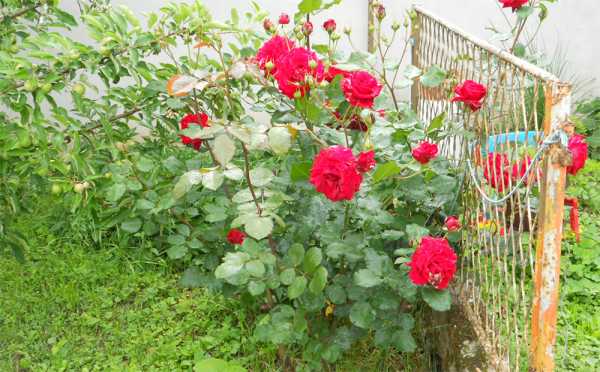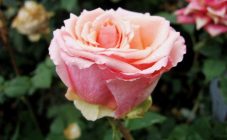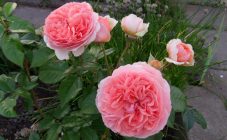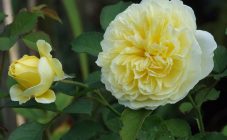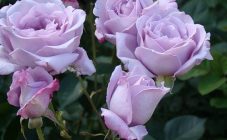Content:
Rosa Don Juan was first introduced to the world by Italian breeders in 1958 and immediately gained popularity. All the leading positions among crimson roses have been hers for many years.
The climbing bush is generously strewn with crimson double flowers all summer. This varietal culture is a great decoration for any garden.
Characteristics and features
Although the don Juan rose is climbing, it is used as a standard species. Erect stems form a very massive shrub, densely covered with dark green leathery leaves.
The usual height of the bush is 2.5 m, but favorable conditions significantly increase this barrier.
Don Juan rose is endowed with increased resistance to rain, which is characteristic of climbing crops. The flower is relatively frost-resistant, in the Middle lane it needs winter shelter.
Agricultural technology of cultivation
Usually climbing bushes of roses are planted near arbors, arches, they decorate fences and fences. Experts do not advise planting roses in the corners of buildings, since in such places there are frequent gusts of wind that are poorly tolerated by flowers.
Rose Don Juan does not tolerate waterlogging very well; therefore, seedlings are not planted in swampy peaty natural soils. If there is such a problem, the site is drained and transformed before planting the bushes.
The rose bush is propagated in several ways:
- graft. The eye of the culture is grafted onto the rosehip;
- grafting. When the stem has faded, you can cut off the stalk from it. They plant it in the ground at an angle and cover it with a plastic bottle;
- layering. The lowest stem is carefully tilted and instilled. By autumn, the stem will sprout roots, and in the spring it is separated;
- division of the bush. When the shrub is transferred to another place, it is divided into parts with a minimum of 2 branches.
Seedlings prepared for planting are best preserved in dark basements or cool closets. It is very important for the preservation of the roots to pre-wrap them with damp paper or rags. The entire storage period must be revised planting material in order to prevent drying out or decay in time.
Planting a rose
For the normal development of culture, lush color and the absence of diseases, it is necessary that planting be carried out taking into account some recommendations:
- the chosen place should be calm;
- shrub in the first half of the day needs bright sun.
Fortified seedlings must be planted in an open area at the beginning of autumn, so that by the first frost they have time to take root. After the Don Juan winter rest, the climbing rose will actively develop.
At the end of spring, a flower can be planted, but it is undesirable, since it will lag behind in development. For spring plantings, shoots with a height of 15 cm are needed, and the rhizome should be about 30 cm. Before planting, they are immersed in water, keeping there for a day.
The hole is dug to a depth of half a meter and a diameter of about 60 cm. It is filled with mineral-enriched substrate and moisture-absorbing puffy soil with humus. To partially neutralize the acidity of the soil, ash is poured into the hole. After finishing planting, a support is installed, the seedling is covered with a film.
When fixing branches to the racks, it is better to use plastic twine, and refuse from metal wire: if damaged, an infection can get into the wound of the stem. The lattice is installed half a meter from the bush so that the roots are not injured. After finishing planting, the rose is generously watered and hilled.
Transfer
It is not recommended to replant Rose Don Juan. However, it is necessary to transplant from an unfortunate place where the culture is often sick. You need to do this operation in early October so that the rose has the opportunity to take root.
First of all, the bush is removed from the supports, then it is shortened by half. From the root of the bush, they outline a circle with a diameter of half a meter and dig in. After pulling out the plant, shake it a little and cut off the thin roots with a pruner.
Rose care
Water and feed on time with appropriate fertilizers - everything that is included in the basic care of Don Juan roses. It is very important for delicate plants that there are no crusts on the surface of the soil after watering. To prevent this, the soil must be loosened and mulched in a timely manner.
As for the fertilizers, those that were used when laying in the hole will be enough until next year. From the second year, it will be necessary to carry out annual feeding:
- immediately after the snow melts, the bush is fed with ammonium nitrate. After half a month, the procedure is repeated;
- during the formation of buds, the culture is watered with a special fertilizer;
- when the first flowers begin to open, the rose is fed with a solution of mullein or bird droppings. This procedure can significantly extend the flowering period;
- at the end of the primary flowering, the rose needs mineral fertilizers with magnesium, phosphorus, potassium;
- in early August, the shrub must receive a special fertilizer for Rosaceae;
- in September, the flower must be given a potassium mixture or superphosphate.
Bush formation
Climbing rose buds are knocked out only on young shoots that have grown in this season. For the fullness of the color, it is necessary to promote their increase and growth.
Annual shoots should be shortened by a third in the fall. Unripe twigs are removed completely, because, as the weakest area, they can freeze and cause the development of diseases and pests.
When planting a rose near low fences, it is recommended to form it with a fan, evenly directing the shoots. Near other supports, it is advisable to allow the shrub to grow arbitrarily, the main thing is that it can grab the support.
Preparing for winter
Despite the sufficient frost resistance, the shrub may die during severe frosts. It is necessary to cover the plant only after the establishment of stable frosty weather. During thaws, the roses may podoprevaniya, which in frost will destroy it.
Dry foliage and flowers must be removed from the rose bush. Next to the bush, a litter of spruce branches is laid out. The branches of the rose are carefully removed from the base and placed on this pillow. Spruce or pine branches are also placed on top of the plant. Cover the structure with non-woven fabric. The base of the shrub is covered with a mixture of dry manure and soil.
With the arrival of spring, the winter protection is removed gradually. After the snow melts, the material is first removed. The remaining spruce branches will help the rose survive return frosts. When heat is established, spruce branches are also removed.
The shrub is freed from the soil, the stems are carefully straightened and distributed over the support, fixing securely.
Pros and cons of rose
The description of the Don Juan rose highlights its main advantage - excellent resistance to heavy and prolonged rains, keeping its freshness for a long time.
Long-term flowering occurs due to the constant formation of buds on the shoots.Throughout the summer, the crimson flower buds grow continuously, and the impression of constant flowering is created.
The shrub has only one drawback - it cannot withstand severe frosts, therefore it needs shelter.
If you adhere to all the nuances and tips, then the Don Juan rose bush will decorate any garden with lush flowering for many years.



